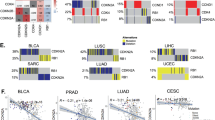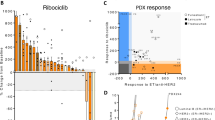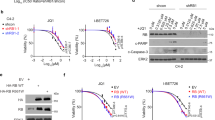Abstract
Mutations of the retinoblastoma tumor-suppressor gene (RB1) or components regulating the CDK-RB-E2F pathway have been identified in nearly every human malignancy. Re-establishing cell cycle control through cyclin-dependent kinase (CDK) inhibition has therefore emerged as an attractive option in the development of targeted cancer therapy. The most successful example of this today is the use of the CDK4/6 inhibitor palbociclib combined with aromatase inhibitors for the treatment of estrogen receptor-positive breast cancers. Multiple studies have demonstrated that the CDK-RB-E2F pathway is critical for the control of cell proliferation. More recently, studies have highlighted additional roles of this pathway, especially E2F transcription factors themselves, in tumor progression, angiogenesis and metastasis. Specific E2Fs also have prognostic value in breast cancer, independent of clinical parameters. We discuss here recent advances in understanding of the RB-E2F pathway in breast cancer. We also discuss the application of genome-wide genetic screening efforts to gain insight into synthetic lethal interactions of CDK4/6 inhibitors in breast cancer for the development of more effective combination therapies.
This is a preview of subscription content, access via your institution
Access options
Subscribe to this journal
Receive 50 print issues and online access
$259.00 per year
only $5.18 per issue
Buy this article
- Purchase on Springer Link
- Instant access to full article PDF
Prices may be subject to local taxes which are calculated during checkout


Similar content being viewed by others
References
Baker SJ, Reddy EP . CDK4: a key player in the cell cycle, development, and cancer. Genes Cancer 2012; 3: 658–669.
Malumbres M, Barbacid M . Cell cycle, CDKs and cancer: a changing paradigm. Nat Rev Cancer 2009; 9: 153–166.
Chen HZ, Tsai SY, Leone G . Emerging roles of E2Fs in cancer: an exit from cell cycle control. Nat Rev Cancer 2009; 9: 785–797.
Chong JL, Wenzel PL, Saenz-Robles MT, Nair V, Ferrey A, Hagan JP et al. E2f1-3 switch from activators in progenitor cells to repressors in differentiating cells. Nature 2009; 462: 930–934.
Liu H, Tang X, Srivastava A, Pecot T, Daniel P, Hemmelgarn B et al. Redeployment of Myc and E2f1-3 drives Rb-deficient cell cycles. Nat Cell Biol 2015; 17: 1036–1048.
Sadasivam S, DeCaprio JA . The DREAM complex: master coordinator of cell cycle-dependent gene expression. Nat Rev Cancer 2013; 13: 585–595.
Yamasaki L, Jacks T, Bronson R, Goillot E, Harlow E, Dyson NJ . Tumor induction and tissue atrophy in mice lacking E2F-1. Cell 1996; 85: 537–548.
Rowland BD, Denissov SG, Douma S, Stunnenberg HG, Bernards R, Peeper DS . E2F transcriptional repressor complexes are critical downstream targets of p19(ARF)/p53-induced proliferative arrest. Cancer Cell 2002; 2: 55–65.
Berthet C, Aleem E, Coppola V, Tessarollo L, Kaldis P . Cdk2 knockout mice are viable. Curr Biol 2003; 13: 1775–1785.
Berthet C, Klarmann KD, Hilton MB, Suh HC, Keller JR, Kiyokawa H et al. Combined loss of Cdk2 and Cdk4 results in embryonic lethality and Rb hypophosphorylation. Dev Cell 2006; 10: 563–573.
Malumbres M, Sotillo R, Santamaria D, Galan J, Cerezo A, Ortega S et al. Mammalian cells cycle without the D-type cyclin-dependent kinases Cdk4 and Cdk6. Cell 2004; 118: 493–504.
Ortega S, Prieto I, Odajima J, Martin A, Dubus P, Sotillo R et al. Cyclin-dependent kinase 2 is essential for meiosis but not for mitotic cell division in mice. Nat Genet 2003; 35: 25–31.
Santamaria D, Barriere C, Cerqueira A, Hunt S, Tardy C, Newton K et al. Cdk1 is sufficient to drive the mammalian cell cycle. Nature 2007; 448: 811–815.
Bernards R, Weinberg RA . A progression puzzle. Nature 2002; 418: 823.
Yoon SO, Shin S, Mercurio AM . Ras stimulation of E2F activity and a consequent E2F regulation of integrin alpha6beta4 promote the invasion of breast carcinoma cells. Cancer Res 2006; 66: 6288–6295.
Sage J . The retinoblastoma tumor suppressor and stem cell biology. Genes Dev 2012; 26: 1409–1420.
Arima Y, Hayashi H, Sasaki M, Hosonaga M, Goto TM, Chiyoda T et al. Induction of ZEB proteins by inactivation of RB protein is key determinant of mesenchymal phenotype of breast cancer. J Biol Chem 2012; 287: 7896–7906.
Johnson JL, Pillai S, Pernazza D, Sebti SM, Lawrence NJ, Chellappan SP . Regulation of matrix metalloproteinase genes by E2F transcription factors: Rb-Raf-1 interaction as a novel target for metastatic disease. Cancer Res 2012; 72: 516–526.
Pillai S, Trevino J, Rawal B, Singh S, Kovacs M, Li X et al. Beta-arrestin-1 mediates nicotine-induced metastasis through E2F1 target genes that modulate epithelial-mesenchymal transition. Cancer Res 2015; 75: 1009–1020.
Witkiewicz AK, Cox DW, Rivadeneira D, Ertel AE, Fortina P, Schwartz GF et al. The retinoblastoma tumor suppressor pathway modulates the invasiveness of ErbB2-positive breast cancer. Oncogene 2014; 33: 3980–3991.
Bos PD, Zhang XH, Nadal C, Shu W, Gomis RR, Nguyen DX et al. Genes that mediate breast cancer metastasis to the brain. Nature 2009; 459: 1005–1009.
Kang Y, Siegel PM, Shu W, Drobnjak M, Kakonen SM, Cordon-Cardo C et al. A multigenic program mediating breast cancer metastasis to bone. Cancer Cell 2003; 3: 537–549.
Minn AJ, Gupta GP, Siegel PM, Bos PD, Shu W, Giri DD et al. Genes that mediate breast cancer metastasis to lung. Nature 2005; 436: 518–524.
Fujiwara K, Yuwanita I, Hollern DP, Andrechek ER . Prediction and genetic demonstration of a role for activator E2Fs in Myc-induced tumors. Cancer Res 2011; 71: 1924–1932.
Opavsky R, Tsai SY, Guimond M, Arora A, Opavska J, Becknell B et al. Specific tumor suppressor function for E2F2 in Myc-induced T cell lymphomagenesis. Proc Natl Acad Sci USA 2007; 104: 15400–15405.
Yuwanita I, Barnes D, Monterey MD, O'Reilly S, Andrechek ER . Increased metastasis with loss of E2F2 in Myc-driven tumors. Oncotarget 2015; 6: 38210–38224.
Fluck MM, Schaffhausen BS . Lessons in signaling and tumorigenesis from polyomavirus middle T antigen. Microbiol Mol Biol Rev 2009; 73: 542–563; Table of contents.
Hollern DP, Honeysett J, Cardiff RD, Andrechek ER . The E2F transcription factors regulate tumor development and metastasis in a mouse model of metastatic breast cancer. Mol Cell Biol 2014; 34: 3229–3243.
Wu L, de Bruin A, Wang H, Simmons T, Cleghorn W, Goldenberg LE et al. Selective roles of E2Fs for ErbB2- and Myc-mediated mammary tumorigenesis. Oncogene 2015; 34: 119–128.
Andrechek ER . HER2/Neu tumorigenesis and metastasis is regulated by E2F activator transcription factors. Oncogene 2015; 34: 217–225.
Trikha P, Sharma N, Pena C, Reyes A, Pecot T, Khurshid S et al. E2f3 in tumor macrophages promotes lung metastasis. Oncogene 2015, e-pub ahead of print 9 November 2015 doi:10.1038/onc.2015.429.
Prat A, Perou CM . Deconstructing the molecular portraits of breast cancer. Mol Oncol 2011; 5: 5–23.
Ye X, Weinberg RA . Epithelial-mesenchymal plasticity: a central regulator of cancer progression. Trends Cell Biol 2015; 25: 675–686.
Bild AH, Yao G, Chang JT, Wang Q, Potti A, Chasse D et al. Oncogenic pathway signatures in human cancers as a guide to targeted therapies. Nature 2006; 439: 353–357.
Gatza ML, Lucas JE, Barry WT, Kim JW, Wang Q, Crawford MD et al. A pathway-based classification of human breast cancer. Proc Natl Acad Sci USA 2010; 107: 6994–6999.
van 't Veer LJ, Dai H, van de Vijver MJ, He YD, Hart AA, Mao M et al. Gene expression profiling predicts clinical outcome of breast cancer. Nature 2002; 415: 530–536.
van de Vijver MJ, He YD, van't Veer LJ, Dai H, Hart AA, Voskuil DW et al. A gene-expression signature as a predictor of survival in breast cancer. N Engl J Med 2002; 347: 1999–2009.
West M, Blanchette C, Dressman H, Huang E, Ishida S, Spang R et al. Predicting the clinical status of human breast cancer by using gene expression profiles. Proc Natl Acad Sci USA 2001; 98: 11462–11467.
Ben-Porath I, Thomson MW, Carey VJ, Ge R, Bell GW, Regev A et al. An embryonic stem cell-like gene expression signature in poorly differentiated aggressive human tumors. Nat Genet 2008; 40: 499–507.
Niida A, Smith AD, Imoto S, Tsutsumi S, Aburatani H, Zhang MQ et al. Integrative bioinformatics analysis of transcriptional regulatory programs in breast cancer cells. BMC Bioinform 2008; 9: 404.
Niida A, Smith AD, Imoto S, Aburatani H, Zhang MQ, Akiyama T . Gene set-based module discovery in the breast cancer transcriptome. BMC Bioinform 2009; 10: 71.
Tian S, Roepman P, Van't Veer LJ, Bernards R, de Snoo F, Glas AM . Biological functions of the genes in the mammaprint breast cancer profile reflect the hallmarks of cancer. Biomarker Insights 2010; 5: 129–138.
Huang L, Zhao S, Frasor JM, Dai Y . An integrated bioinformatics approach identifies elevated cyclin E2 expression and E2F activity as distinct features of tamoxifen resistant breast tumors. PloS One 2011; 6: e22274.
Chanrion M, Negre V, Fontaine H, Salvetat N, Bibeau F, Mac Grogan G et al. A gene expression signature that can predict the recurrence of tamoxifen-treated primary breast cancer. Clin Cancer Res 2008; 14: 1744–1752.
Loi S, Piccart M, Sotiriou C . The use of gene-expression profiling to better understand the clinical heterogeneity of estrogen receptor positive breast cancers and tamoxifen response. Crit Rev Oncol Hematol 2007; 61: 187–194.
Loi S, Haibe-Kains B, Desmedt C, Wirapati P, Lallemand F, Tutt AM et al. Predicting prognosis using molecular profiling in estrogen receptor-positive breast cancer treated with tamoxifen. BMC Genomics 2008; 9: 239.
Lin X, Li J, Yin G, Zhao Q, Elias D, Lykkesfeldt AE et al. Integrative analyses of gene expression and DNA methylation profiles in breast cancer cell line models of tamoxifen-resistance indicate a potential role of cells with stem-like properties. Breast Cancer Res 2013; 15: R119.
Zhu M, Liu CC, Cheng C . REACTIN: regulatory activity inference of transcription factors underlying human diseases with application to breast cancer. BMC Genomics 2013; 14: 504.
Khaleel SS, Andrews EH, Ung M, DiRenzo J, Cheng C . E2F4 regulatory program predicts patient survival prognosis in breast cancer. Breast Cancer Res 2014; 16: 486.
Rakha EA, Pinder SE, Paish EC, Robertson JF, Ellis IO . Expression of E2F-4 in invasive breast carcinomas is associated with poor prognosis. J Pathol 2004; 203: 754–761.
Thomassen M, Tan Q, Kruse TA . Gene expression meta-analysis identifies metastatic pathways and transcription factors in breast cancer. BMC Cancer 2008; 8: 394.
Singh S, Johnson J, Chellappan S . Small molecule regulators of Rb-E2F pathway as modulators of transcription. Biochim Biophys Acta 2010; 1799: 788–794.
Bose P, Simmons GL, Grant S . Cyclin-dependent kinase inhibitor therapy for hematologic malignancies. Exp Opin Investig Drugs 2013; 22: 723–738.
Cai D, Latham Jr VM, Zhang X, Shapiro GI . Combined depletion of cell cycle and transcriptional cyclin-dependent kinase activities induces apoptosis in cancer cells. Cancer Res 2006; 66: 9270–9280.
Canduri F, Perez PC, Caceres RA, de Azevedo WF Jr . CDK9 a potential target for drug development. Med Chem 2008; 4: 210–218.
Vandenbosch R, Borgs L, Beukelaers P, Foidart A, Nguyen L, Moonen G et al. CDK2 is dispensable for adult hippocampal neurogenesis. Cell Cycle 2007; 6: 3065–3069.
Finn RS, Crown JP, Lang I, Boer K, Bondarenko IM, Kulyk SO et al. The cyclin-dependent kinase 4/6 inhibitor palbociclib in combination with letrozole versus letrozole alone as first-line treatment of oestrogen receptor-positive, HER2-negative, advanced breast cancer (PALOMA-1/TRIO-18): a randomised phase 2 study. Lancet Oncol 2015; 16: 25–35.
Fry DW, Harvey PJ, Keller PR, Elliott WL, Meade M, Trachet E et al. Specific inhibition of cyclin-dependent kinase 4/6 by PD 0332991 and associated antitumor activity in human tumor xenografts. Mol Cancer Ther 2004; 3: 1427–1438.
Toogood PL, Harvey PJ, Repine JT, Sheehan DJ, VanderWel SN, Zhou H et al. Discovery of a potent and selective inhibitor of cyclin-dependent kinase 4/6. J Med Chem 2005; 48: 2388–2406.
Finn RS, Dering J, Conklin D, Kalous O, Cohen DJ, Desai AJ et al. PD 0332991, a selective cyclin D kinase 4/6 inhibitor, preferentially inhibits proliferation of luminal estrogen receptor-positive human breast cancer cell lines in vitro. Breast Cancer Res 2009; 11: R77.s.
Sabbah M, Courilleau D, Mester J, Redeuilh G . Estrogen induction of the cyclin D1 promoter: involvement of a cAMP response-like element. Proc Natl Acad Sci USA 1999; 96: 11217–11222.
Dickson MA . Molecular pathways: CDK4 inhibitors for cancer therapy. Clin Cancer Res 2014; 20: 3379–3383.
Vora SR, Juric D, Kim N, Mino-Kenudson M, Huynh T, Costa C et al. CDK 4/6 inhibitors sensitize PIK3CA mutant breast cancer to PI3K inhibitors. Cancer Cell 2014; 26: 136–149.
Farmer H, McCabe N, Lord CJ, Tutt AN, Johnson DA, Richardson TB et al. Targeting the DNA repair defect in BRCA mutant cells as a therapeutic strategy. Nature 2005; 434: 917–921.
Prahallad A, Sun C, Huang S, Di Nicolantonio F, Salazar R, Zecchin D et al. Unresponsiveness of colon cancer to BRAF(V600E) inhibition through feedback activation of EGFR. Nature 2012; 483: 100–103.
Mermel CH, Schumacher SE, Hill B, Meyerson ML, Beroukhim R, Getz G . GISTIC2.0 facilitates sensitive and confident localization of the targets of focal somatic copy-number alteration in human cancers. Genome Biol 2011; 12: R41.
Acknowledgements
The work of RB and LFAW is supported by grants of The Dutch Cancer Society and the and by the Cancer Genomics Netherlands consortium. MG’s work is supported by the Wellcome Trust (102696), the Dutch Cancer Society (H1/2014-6919), Stand Up 2 Cancer and a European Research Council Synergy grant.
Author information
Authors and Affiliations
Corresponding author
Ethics declarations
Competing interests
The authors declare no conflict of interest.
Rights and permissions
About this article
Cite this article
Johnson, J., Thijssen, B., McDermott, U. et al. Targeting the RB-E2F pathway in breast cancer. Oncogene 35, 4829–4835 (2016). https://doi.org/10.1038/onc.2016.32
Received:
Revised:
Accepted:
Published:
Issue Date:
DOI: https://doi.org/10.1038/onc.2016.32
This article is cited by
-
Single-Cell Transcription Mapping of Murine and Human Mammary Organoids Responses to Female Hormones
Journal of Mammary Gland Biology and Neoplasia (2024)
-
Silencing TRAIP suppresses cell proliferation and migration/invasion of triple negative breast cancer via RB-E2F signaling and EMT
Cancer Gene Therapy (2023)
-
The RNA-binding protein LRPPRC promotes resistance to CDK4/6 inhibition in lung cancer
Nature Communications (2023)
-
CDK16 promotes the progression and metastasis of triple-negative breast cancer by phosphorylating PRC1
Journal of Experimental & Clinical Cancer Research (2022)
-
ZL-n-91, a specific Phosphodiesterase-4 inhibitor, suppresses the growth of triple-negative breast cancer
Investigational New Drugs (2022)



